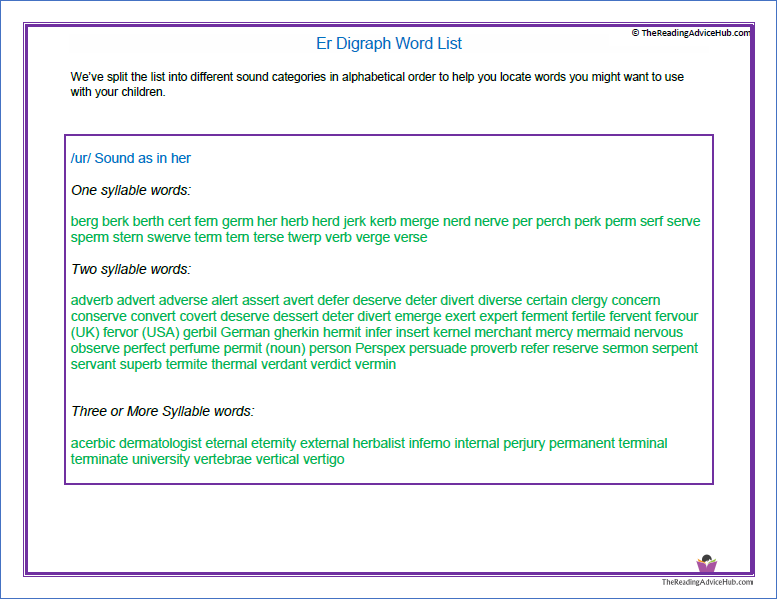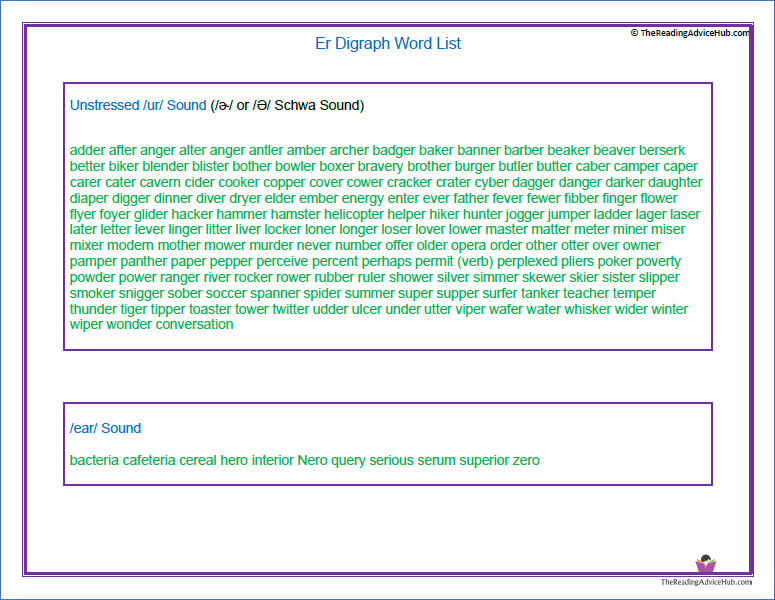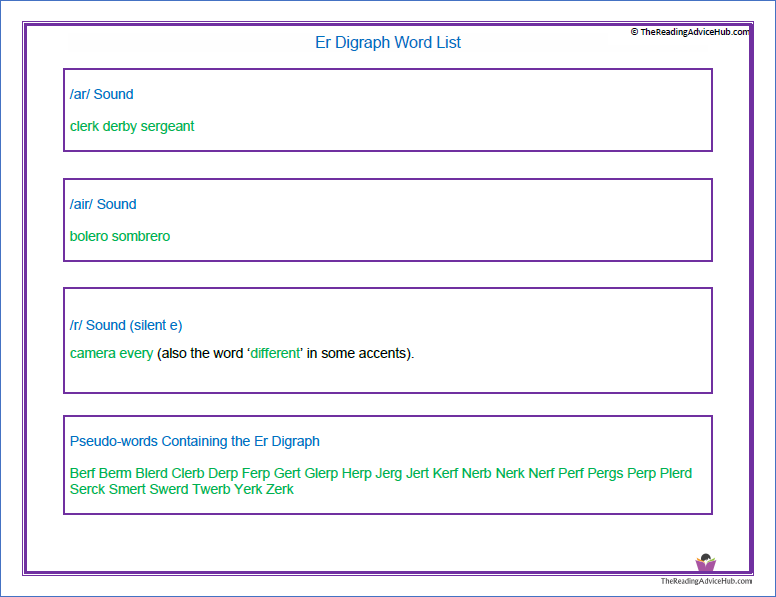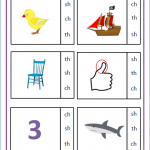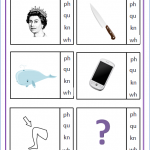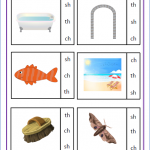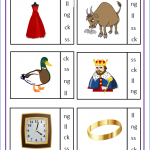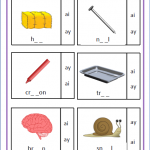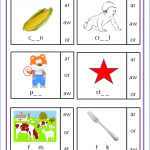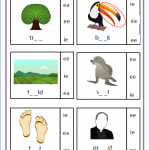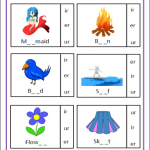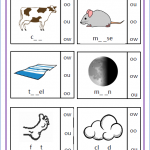Er digraph examples, word lists and free worksheets and games for phonics teaching.
Introduction
The ‘er’ digraph is one of the most common vowel graphemes in English. It’s sometimes described as an ‘r-controlled vowel’ or ‘murmur diphthong’, although these phrases are rarely used in phonics teaching in the UK.
Contents:
- Er Digraph Sounds
- Er Digraph Word List
- /ur/ Sound as in her
- Unstressed /ur/ Sound
- /ear/ Sound
- /ar/ Sound
- /air/ Sound
- /r/ Sound (silent e)
- Pseudo-words Containing the Er Digraph
- Words Where Er Doesn’t Act as a Digraph
- Er Digraph Worksheets
- Er Digraph Phonics Games Online
- Other Free Digraph Resources
Er Digraph Sounds
The most common sound associated with the er digraph is the /ur/ sound, which is found in words such as ‘her’, kerb, herd, term and person. The same sound is sometimes represented by other digraphs such as ‘ir’ in bird and ‘ur’ in burn.
There’s some variation in the way the digraph is pronounced in different English-speaking countries and even within different regions in the same country.
The International Phonetic Alphabet (IPA) symbol for this sound is /ɜ:/ in British RP English and /ɝ/ in American English. You can hear the sounds in the Wikipedia IPA Help page.
A similar, sound is often pronounced when the digraph represents part of an unstressed syllable. However, the sound is said in a more relaxed way, which means it’s said a bit more quickly and quietly with a lower tone.
This happens most often at the end of words with more than one syllable. For example, in words such as flower, supper and mixer. However, it can also occur in words with an initial unstressed syllable such as berserk and perhaps.
The IPA symbol for this sound is /ɚ/ in American English. The ‘Sounds American’ videos below give a thorough description of the alternative pronunciations of the common sounds for the er digraph in American accents.
And the video below gives a more detailed explanation of how to differentiate between the two sounds:
In some British English and Australian accents, the ‘er’ digraph is pronounced as an unstressed ‘uh’ sound when it appears in unstressed syllables.
For example, it’s common to hear people say ‘flowuh’ or ‘buttuh’ instead of flower and butter.
The technical term for the ‘uh’ sound in these examples is the schwa, which has the following symbol: /Ə/. We discuss this in more detail in our article on the schwa sound.
The popular English phonics teacher Mr Thorne discusses the pronunciation in British English and gives several examples in the video below:
Most teachers in England introduce the digraph as the fully pronounced /ur/ sound at first, no matter where it occurs in words. This is demonstrated in the ‘Little Learners’ video on blending er words below:
An exaggerated, fully stressed pronunciation can be helpful when children are first learning to read new digraphs, and it can also help them to remember the correct spellings.
Even though their pronunciation might sound a bit robotic at first, children gradually start to recognise the letter patterns more quickly and eventually say the words in a way that’s closer to their spoken accent. However, learners who are non-native speakers of English might need a bit more support.
The er digraph can represent a few other sounds, but all of these are much less common than the /ur/ sound mentioned above. Nevertheless, it’s worth pointing out some of these examples to children once they’ve mastered the most common sounds.
The alternative sounds for ‘er’ include:
- /ear/ as in cafeteria, cereal, hero, zero
- /ar/ as in clerk, Derby and sergeant
- /air/ as in bolero and sombrero (usually words from non-English speaking parts of Europe)
- /r/ (silent e) as in every, camera (and different in some accents).
It’s also worth pointing out to children that in some words ‘er’ doesn’t act as a digraph at all. This normally happens when the letter pair is at the boundary between two syllables.
For example, the letters ‘e’ and ‘r’ are pronounced as separate sounds in the words ‘very’, ‘peril’ and ‘cleric’.
Teach children to try the separate sounds when none of the alternative digraph sounds help them to sound out a recognisable word. If the word still doesn’t make sense to them, then it might be outside their vocabulary and they should ask an adult for help.
Er Digraph Word List
We’ve split the list into different sound categories in alphabetical order to help you locate words you might want to use with your children.
Initially, it’s best to use words that students are familiar with, but as they get more proficient, it’s good to introduce some new words to expand their vocabulary and refine their decoding skills.
Click on the following link or the images below to download a free printable pdf version of the er digraph word list.
You will notice that we’ve also included pseudowords in the word list. These are sometimes described as non-words or nonsense words and they’re used in some phonics programmes and in the UK Phonics Screening Check.
These words are designed to assess whether children are capable of decoding words that are unfamiliar to them.
Normally, a pseudoword will be presented next to an image of a monster or an alien, and the child is told that the word represents the creature’s name. The examples below are from the 2017 phonics screening check.
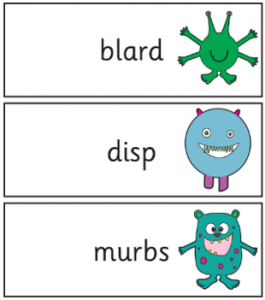
You could use some of the pseudo words in our list as practice words for a screening check or as part of a less formal assessment of a child’s decoding ability.
Words Where Er Doesn’t Act as a Digraph
This generally happens in multi-syllable words the letter pair is at the boundary between 2 syllables. Examples include:
beret berry Beryl cherry cleric Eric Erica erase erect erode error erupt heron feral ferret ferry merit merry peril serif sheriff very
Er Digraph Worksheets
We’ve created the following worksheets that you to download for free. Click on the headings or the images below to access these resources. We’ve also made free PowerPoint versions of some of the resources.
You can download resources for other digraphs from our free digraph worksheets page.
Children need to decide which pictures represent words that contain the ‘er’ digraph. They can also try to spell the words.
Click on the following link for a free PowerPoint version of this resource.
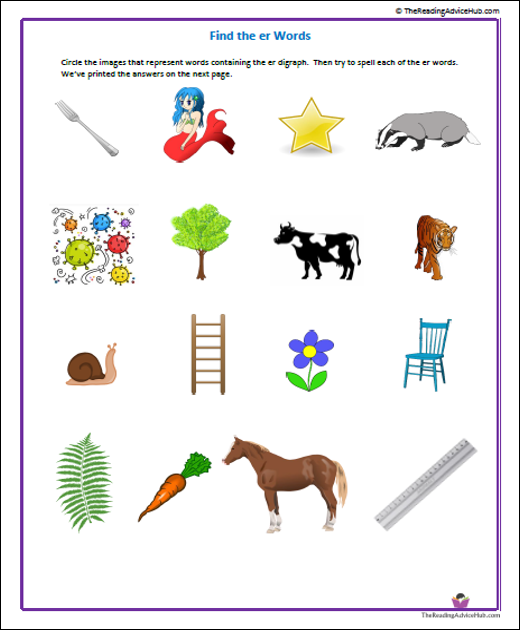
Each of the sentences on the worksheet has a word missing that contains the ‘er’ digraph. Children need to fill in the missing word to complete each sentence.
Click on the following link for a free PowerPoint version of this resource.
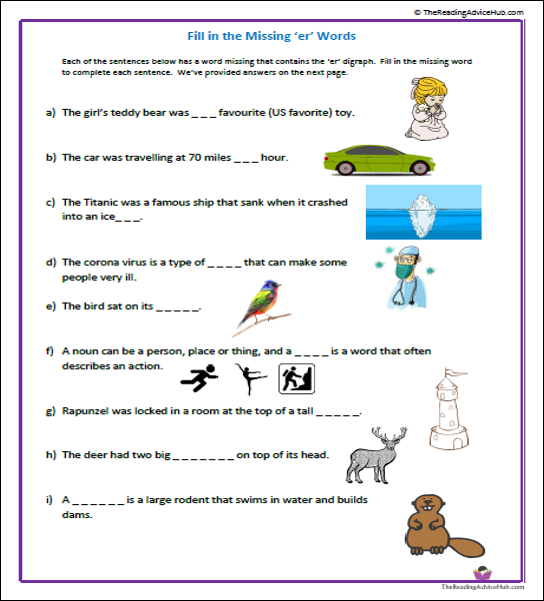
Circle the Vowel Digraph er, ir, and ur
Children have to choose the correct digraph to complete the spelling of each word. This is a more advanced activity because each digraph can represent the same sound.
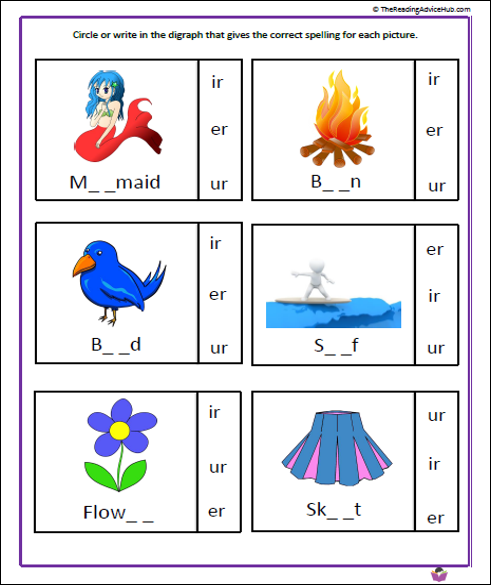
You can download resources for other digraphs from our free digraph worksheets page.
Er Digraph Phonics Games Online
The spellzone website has some free games using words containing the er digraph. They also have a variety of other games that require you to sign up and pay a subscription, but they do offer a free trial.
Click on the following link for the spellzone games for words containing the er digraph.
The Spellingframe website also has a variety of activities for practising spelling er words. Like the spellzone website, you have to sign up and pay a subscription to access all of the games.
The SplashLearn website also has some activities for practising blending and spelling oa words. You have to sign up to access all the activities but it’s free to try it.
Other Free Digraph Resources
A variety of free worksheets and other resources for a number of common digraphs.
